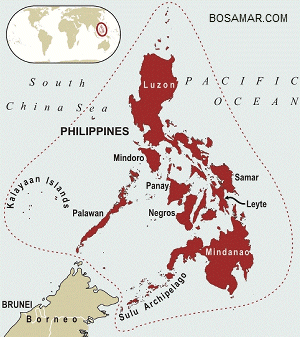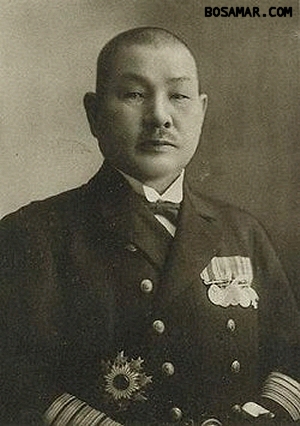
COMMENTS ARE ENABLED ON THE BOTTOM OF THE PAGE
Chapter 1
OPERATION SHŌ-GO
| Between October 23 and 26, 1944 the United States Navy and the Imperial Japanese Combined Fleet fought a crucial series of sea battles for the control of the Philippine Islands. These battles were collectively recorded in U.S. Naval history as the Battle of Leyte Gulf.
|
 |
| Philippine archipelago |
All battles took place in or near the Philippine archipelago, a group of over seven thousand islands, in the center of the Japanese "Greater East Asia Co-Prosperity Sphere." Prior to the war in the Pacific and the subsequent Japanese invasion, the Philippines had been under American dominance. They were a spoils of war bounty obtained by the Americans shortly after Commodore Dewey’s Asiatic Squadron defeated the Spanish fleet in the Battle of Manila Bay in 1898.
Over seventy major Japanese warships participated in the Battle of Leyte Gulf, nearly the entire remaining fighting strength of the Imperial Japanese Navy Combined Fleet. They faced an enormous U.S. Pacific Fleet which consisted of over 120 major surface combatants, including eight heavy and eight light aircraft carriers. During the Battle of Leyte Gulf, nearly every type of warship and weapon system developed to date was utilized by both sides, truly making it the greatest naval battle in history.
The great diversity in naval warfare in which this battle was fought is shown below:
- submarine attacks by both sides
- aircraft-to-aircraft attacks
- land based air attacks on ships
- one of the longest range carrier attacks of the Pacific
- warship-to-ship attacks including the last battle-line, battleship-to-battleship encounter of the Pacific war
- the first true Kamikaze suicide plane attacks of the Pacific war
Admiral Soemu Toyoda, Commander in Chief of the Imperial Japanese Combined Fleet, and his staff were the masterminds of Operation SHŌ-GO. It was an operation which, if it worked, was aimed at stopping the American advance in the Pacific. Coming too late in the war, it was a plan of desperation. At this point in the Pacific war, Japan was already a defeated nation. Nearly three years of war with the Americans had taken its deadly toll on their navy and other armed forces. Japan had been at war continuously since September 18, 1931, when they invaded and conquered the Chinese portion of Manchuria.
| In the summer of 1944, after their devastating defeat in the Marianas, the Japanese conceived Operation SHŌ-GO. It was a plan for the strategic defense of the Japanese home islands that encompassed the four land areas thought possible for the next American offensive drive towards their homeland.
The first and most likely American objective, the Philippine Islands, was given the designation SHŌ-1. An American attack here would effectively cut the empire in half and separate the homeland from its vast resources located in the south. The next logical landmass, designated SHŌ-2, was the defense of the southern chain of home islands which consisted of Formosa, the Ryukyus (which included Okinawa), and the large southern home island of Kyushu, on which lay the militarized cities of Nagasaki and Sasebo. The main home island of Honshu, the least likely invasion point, was designated SHŌ-3. An invasion here appeared to be least likely since it contained the bulk of the population. Last, SHŌ-4, was planned to be executed upon the American invasion of the northern island of Hokkaido. In July 1944 President Franklin D. Roosevelt met at Pearl Harbor Hawaii with Fleet Admiral Chester Nimitz and General Douglas MacArthur to discuss the next move the Americans would make in the Pacific. The selection of the Philippine Islands as the next invasion point, particularly Leyte, would completely sever the lifeblood of Japan. Its precious raw materials and oil, located throughout the south, were badly needed by the empire and would have to be defended to the last man. Losing the Philippines would bring untold disaster for the Japanese military forces and their homeland, effectively ending thirteen years of war. |
 |
|
National Archives Photograph Admiral Soemu Toyoda, IJN |
When the Japanese realized the island of Leyte in the central Philippines was the next American invasion point, SHŌ-GO was implemented. A bold daylight sortie would be made by all available fleet assets to converge on Leyte Gulf to repel the American landings. Timing, of course, was critical. The attack on the American beachhead was scheduled to take place within two days of the American landings, when their transport ships would be most vulnerable to ship and air attack.
During September, the Japanese airfields in the south and central Philippines came under heavy attack from Admiral Halsey's Third Fleet Task Force 38 aircraft. Over two hundred planes were lost by the Japanese for the loss of 8 American.
After the success of these raids, the landings at Leyte were approved in favor of a landing on Formosa. It was now believed the Japanese position on Luzon and the central Philippines had been weakened significantly. General MacArthur, the main proponent of the Leyte landings, wrote the following letter to President Roosevelt, emphasizing their importance and what the landings would achieve:
"....strategically as well as tactically cut the enemy forces in two. Strategically it will pierce the center of his defensive line extending along the coast of Asia from the Japanese homeland to the tip of Singapore and will enable us to envelope to the north or south as we desire. It severs completely the Japanese from their infamous propaganda slogan of the 'Greater East Asia Co-Prosperity Sphere'. Tactically it divides his forces in two and by by-passing the southern half of the Philippines will result in the savings of possibly fifty thousand American casualties. He had expected us and prepared on Mindanao."
The implications of the Leyte landings filled the Japanese with great dismay. To lose the Philippines would mean the loss of their hard fought Empire and the war.